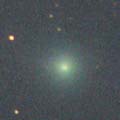
|
Although it was reported so faint as 17 mag at the discovery, it was actually much brighter as 14 mag (Aug. 21, Terry Lovejoy). Then it is brightening rapidly and it is already so bright as 9.1 mag (Nov. 16, Juan Jose Gonzalez). It is getting larger, and better condensed. However, it is locating extremely low in the evening, and it will be unobservable soon. It will pass only 0.17 A.U. from the sun in mid January, and reach to 1 mag. But it is not observable at that time. In the Southern Hemisphere, it appears at 3.5-4 mag in late January, then it keeps observable while fading gradually. In the Northern Hemisphere, it will never be observable again.
Date(TT) R.A. (2000) Decl. Delta r Elong. m1 Best Time(A, h)
Nov. 18 17 4.59 -13 0.1 2.313 1.455 22 8.7 18:20 ( 71, 4)
Nov. 25 17 14.45 -12 31.8 2.212 1.320 19 7.8 18:18 ( 74, 1)
|
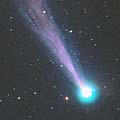
|
After it kept 5.5-6.0 mag from early October to mid October, it suddenly brightened in outburst on Oct. 24, and reached up to 4.2 mag on Oct. 25 (Maik Meyer). It became easily visible with naked eyes, and a very long tail of 5 degrees was visible with binoculars. But now it is fading, and it has already faded down to 7.0 mag (Nov. 16, Juan Jose Gonzalez). In the Northern Hemisphere, it keeps observable in the evening sky until early January while fading gradually after this. In the Southern Hemisphere, it cannot be observable until next April when it becomes fainter than 15 mag.
Date(TT) R.A. (2000) Decl. Delta r Elong. m1 Best Time(A, h)
Nov. 18 19 3.55 14 12.7 1.318 1.217 61 7.8 18:20 ( 75, 44)
Nov. 25 19 32.26 9 17.9 1.492 1.311 59 8.5 18:18 ( 69, 41)
|
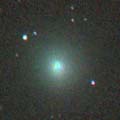
|
It had not been observed for a long time since June. In October, after it appeared again in the morning sky, it brightened very rapidly from 13 mag up to 10 mag. Now it is 9.4 mag (Nov. 14, Juan Jose Gonzalez). It will be at opposition in December and it is coming closer to the earth. So it will keep visible visually at 9-10 mag for a while until December. Bright and large, but weakly condensed. It keeps observable in excellent condition in the Northern Hemisphere. It will fade out rapidly after January.
Date(TT) R.A. (2000) Decl. Delta r Elong. m1 Best Time(A, h)
Nov. 18 9 32.80 16 19.1 1.084 1.532 95 9.2 5:09 (334, 69)
Nov. 25 9 10.07 23 37.3 0.927 1.563 109 8.9 4:56 ( 0, 78)
|
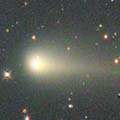
|
Now it reached to the maximum brightness at 9.5 mag (Nov. 14, Juan Jose Gonzalez). Strongly condensed and easy to see. It keeps 9-10 mag until December, and observable in its best condition. It keeps observable after that until May when it fades down to 16 mag. It will be visible visually for a long time until around March.
Date(TT) R.A. (2000) Decl. Delta r Elong. m1 Best Time(A, h)
Nov. 18 2 10.80 3 16.6 0.720 1.668 154 9.5 22:21 ( 0, 58)
Nov. 25 2 13.12 2 32.1 0.749 1.670 147 9.6 21:56 ( 0, 58)
|
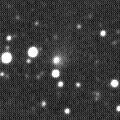
|
Because it has been locating low in the evening sky, a few observations have been reported. CCD observers reported as 14 mag, but it was reported much brighter visually as 11.5 mag (Oct. 14, Juan Jose Gonzalez). It becomes too low in the evening to observe in October and November. But it will be getting higher in the morning sky after December. Then it keeps 13 mag until March and visible visually for a long time.
Date(TT) R.A. (2000) Decl. Delta r Elong. m1 Best Time(A, h)
Nov. 18 15 45.85 12 4.4 2.771 1.994 31 12.7 18:20 (103, 2)
Nov. 25 15 56.29 14 2.4 2.725 1.995 34 12.7 5:15 (255, 3)
|

|
Another outburst occured in mid October, and it became bright up to 11.5 mag (Oct. 16, Maciej Reszelski). Now it is diffuse, but still bright as 12.1 mag (Nov. 11, Jose Carvajal). In this year, it has been bright as 12-13 mag and visible visually since it appeared in the morning sky in early July. It keeps observable in good condition until March.
Date(TT) R.A. (2000) Decl. Delta r Elong. m1 Best Time(A, h)
Nov. 18 4 7.95 31 37.2 4.895 5.856 165 13.2 0:22 ( 0, 87)
Nov. 25 4 4.12 31 26.9 4.885 5.858 169 13.2 23:46 ( 0, 86)
|

|
Recovered after 15 year blank. The condition is good in this return. It was expected to reach to 13.5 mag in November. But it was much fainter than expected by 3 mag, 17.4 mag at the recovery on Oct. 26 (R. H. McNaught). However, it was reported so bright as 12.0 mag on Nov. 13 (Alexandre Amorim). Michael Jager reported it was bright as 14.5 mag on his CCD image on Nov. 15. Although the nuclear magnitude is extremely faint, the total magnitude seems very bright. It is getting higher gradually after this also in the Northern Hemisphere. It will be bright enough to observe in good condition.
Date(TT) R.A. (2000) Decl. Delta r Elong. m1 Best Time(A, h)
Nov. 18 20 53.55 -29 28.5 0.921 1.132 72 13.7 18:20 ( 18, 23)
Nov. 25 21 21.91 -25 8.3 0.910 1.128 72 13.4 18:18 ( 18, 28)
|
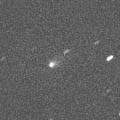
|
It had been unobservble for a long time. When it appeared again in the morning sky, it has showed a cometary activity and it has become much brighter than expected. Now it is also visible visually at 13.7 mag (Oct. 31, Seiichi Yoshida). It keeps 13-14 mag until March. It is observable in good condition in the Southern Hemisphere. However, in the Northern Hemisphere, it rises only up to 20 degree in November, then it moves southwards and is only observable until December.
Date(TT) R.A. (2000) Decl. Delta r Elong. m1 Best Time(A, h)
Nov. 18 11 39.75 -22 17.2 2.420 2.007 54 13.9 5:09 (320, 21)
Nov. 25 11 53.48 -25 52.7 2.362 1.999 56 13.8 5:15 (326, 20)
|

|
It has been lost since its discovery in 1986. The condition is good in this return. In calculation, it was expected to be 14 mag from autumn to winter. But actually, it must be much fainter than expected. Although it has been listed up as an observable target since May, it has not been recovered yet. It was probably in outburst and brightened unexpectedly at the discovery. In the Northern Hemisphere, it keeps observable until it fades out in next spring. It is moving away from the Milky Way, so it will be easier to recover.
Date(TT) R.A. (2000) Decl. Delta r Elong. m1 Best Time(A, h)
Nov. 18 20 42.74 -16 34.7 1.319 1.402 73 13.8 18:20 ( 25, 35)
Nov. 25 21 5.44 -15 1.1 1.347 1.401 71 13.8 18:18 ( 27, 36)
|
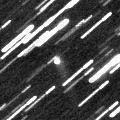
|
Now it is 14.6 mag (Oct. 31, Seiichi Yoshida). Almost asteroidal. It did not brighten at all since early September. Although the slight cometary activity was detected in late July, it became completely stellar soon. However, its tail became visible again in late October. In the Northern Hemisphere, it keeps good condition after this. It keeps locating high until next spring. If it keeps asteroidal after this, it will be 14 mag at best. However, it may suddenly become active and brighten rapidly someday.
Date(TT) R.A. (2000) Decl. Delta r Elong. m1 Best Time(A, h)
Nov. 18 20 46.79 33 24.3 0.942 1.382 91 14.2 18:20 ( 91, 73)
Nov. 25 20 55.32 34 30.9 0.927 1.340 88 14.2 18:18 ( 96, 70)
|
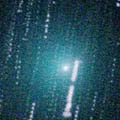
|
Recovered after 117 year blank since 1889. It brightened rapidly in mid July and reached to 8 mag. Then it kept bright at 8 mag with a large diffuse coma until early September. However, now it is fading. It faded down to 12.2 mag on Oct. 31 (Seiichi Yoshida). Then, no visual observations have been reported. It seems to have faded out rapidly in November. It has been already so faint as 15.6 mag by CCD (Nov. 5, Ken-ichi Kadota). In the Northern Hemisphere, it keeps locating very high in the evening sky for a long time after this. However, it will be fainter than 18 mag in December.
Date(TT) R.A. (2000) Decl. Delta r Elong. m1 Best Time(A, h)
Nov. 18 0 28.11 57 39.1 0.854 1.663 128 14.2 20:40 (180, 68)
Nov. 25 0 49.83 53 15.1 0.922 1.738 131 14.8 20:34 (180, 72)
|
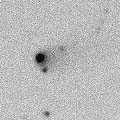
|
It has been visible at 13.5 mag for a long time since last autumn until spring. Although it had been unobservable for a while, now it locates very high in the morning sky. No observations have been reported recently, although it must be bright as 14 mag. It keeps 14 mag and observable in excellent condition until April. Although it is fainter than last year by 1 mag, it will be visible visually at 14 mag.
Date(TT) R.A. (2000) Decl. Delta r Elong. m1 Best Time(A, h)
Nov. 18 12 41.75 23 9.7 5.889 5.452 59 14.4 5:09 (268, 40)
Nov. 25 12 46.95 22 48.8 5.822 5.468 64 14.4 5:15 (272, 46)
|
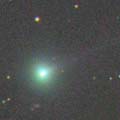
|
New comet discovered visually very near by Saturn. It was very bright, 9.4 mag on Oct. 5 (Juan Jose Gonzalez). But it was fainter than 12 mag in the photo on Sept. 30 (Tetuo Kudo). Probably, it brightened rapidly in early October. It is a short periodic comet with a period of 5.4 years. It may be one of the faint NEOs usually. It faded rather rapidly down to 11.6 mag on Oct. 31 (Seiichi Yoshida). It looked about to be disrupted on Michael Jager and Gerald Rhemann's image. In November, it is getting diffuse rapidly. It has faded down to 13.9 mag on Nov. 8 (Ken-ichi Kadota). It will be too faint to see visually soon. It keeps locating in the morning sky until winter, then it keeps locating observable until next summer. But in the Northern Hemisphere, it becomes low in the south in 2007.
Date(TT) R.A. (2000) Decl. Delta r Elong. m1 Best Time(A, h)
Nov. 18 12 11.49 -12 16.7 1.526 1.146 48 14.5 5:09 (306, 24)
Nov. 25 12 30.62 -15 39.9 1.556 1.195 50 15.4 5:15 (312, 24)
|
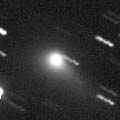
|
It had been observed at 10 mag in the evening sky from winter to spring. Although it has been unobservable since May, now it is appearing in the morning sky again. Now it is 14.2 mag (Oct. 31, Seiichi Yoshida), still visible visually.
Date(TT) R.A. (2000) Decl. Delta r Elong. m1 Best Time(A, h)
Nov. 18 10 4.54 23 58.8 3.501 3.650 90 14.7 5:09 (302, 71)
Nov. 25 10 6.40 23 57.4 3.463 3.718 97 14.8 5:15 (321, 76)
|
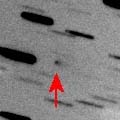
|
It was expected to reach to 13 mag in winter. But actually, it is so faint as 16.5 mag still now (Oct. 25, Mitsunori Tsumura), much fainter than expected. It will be observable in an excellent condition in November and December. However, it reached only to 15.5 mag at best in fact.
Date(TT) R.A. (2000) Decl. Delta r Elong. m1 Best Time(A, h)
Nov. 18 7 49.73 20 7.7 0.864 1.604 119 15.5 4:03 ( 0, 75)
Nov. 25 7 58.92 23 56.4 0.816 1.604 125 15.4 3:44 ( 0, 79)
|

|
It is observable in good condition in the Southern Hemisphere. But it is not observable until January in the Northern Hemisphere. It was discovered at 17.5 mag in May. Then it has not been brightening well. It is 16.5-17 mag still in November. It will be observable also in the Northern Hemisphere in the evening low sky from January to March, however, it will be fainter than 15 mag.
Date(TT) R.A. (2000) Decl. Delta r Elong. m1 Best Time(A, h)
Nov. 18 6 4.32 -66 30.6 2.616 2.793 89 15.5 2:19 ( 0,-12)
Nov. 25 5 28.77 -66 24.3 2.555 2.761 91 15.4 1:16 ( 0,-11)
|
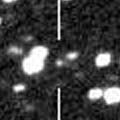
|
In its last apparition, it became brightest about 4 months after the perihelion passage. In this apparition, it was 17.6 mag in late July around the perihelion passage (July 23, Filip Fratev), however, now it brightened up to 15.8 mag (Oct. 27, B. Vasiljevic, R. Palcic). It will be observable at 15.5 mag in good condition from November to January.
Date(TT) R.A. (2000) Decl. Delta r Elong. m1 Best Time(A, h)
Nov. 18 6 3.72 15 34.2 1.173 2.056 143 15.6 2:17 ( 0, 71)
Nov. 25 6 0.03 15 52.3 1.160 2.082 151 15.5 1:46 ( 0, 71)
|

|
Now it is 15.9 mag, as bright as expected (Oct. 25, Ken-ichi Kadota). It is observable at 15.5-16 mag until next spring. But, in the Northern Hemisphere, it locates somewhat low at 20-30 degree high.
Date(TT) R.A. (2000) Decl. Delta r Elong. m1 Best Time(A, h)
Nov. 18 8 7.93 -27 14.1 3.727 3.999 98 15.9 4:21 ( 0, 28)
Nov. 25 7 58.45 -28 53.4 3.623 3.985 104 15.8 3:44 ( 0, 26)
|
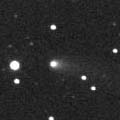
|
It was bright as 13.2 mag on Sept. 27, and visible visually (Seiichi Yoshida). It keeps locating at the same altitude until December. But probably, it is already too faint to see visually.
Date(TT) R.A. (2000) Decl. Delta r Elong. m1 Best Time(A, h)
Nov. 18 22 16.58 -20 12.8 3.225 3.427 93 15.8 18:28 ( 0, 35)
Nov. 25 22 20.93 -19 28.0 3.340 3.441 87 15.9 18:18 ( 4, 36)
|
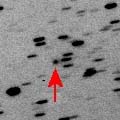
|
Now it is 16.2 mag (Oct. 21, Catalina Sky Survey). A bit fainter than this ephemeris, but it became almost as bright as expected. It keeps 16 mag until December. It keeps observable until February when it becomes fainter than 18 mag.
Date(TT) R.A. (2000) Decl. Delta r Elong. m1 Best Time(A, h)
Nov. 18 10 17.55 -0 14.8 1.594 1.711 79 15.8 5:09 (327, 50)
Nov. 25 10 27.74 -2 50.9 1.559 1.739 82 15.9 5:15 (337, 50)
|
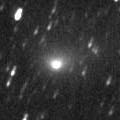
|
It reached up to 10.3 mag on July 7 (Juan Jose Gonzalez). Then it is fading gradually. Now it is 15.0 mag (Oct. 25, Mitsunori Tsumura). It is already invisible visually. It keeps locating at the same altitude in the evening sky until January when it will be fainter than 18 mag.
Date(TT) R.A. (2000) Decl. Delta r Elong. m1 Best Time(A, h)
Nov. 18 21 48.16 -23 36.4 1.990 2.159 85 15.9 18:20 ( 6, 31)
Nov. 25 21 59.66 -22 5.8 2.106 2.197 81 16.2 18:18 ( 10, 32)
|

|
It was in major outburst unexpectedly and reached to 10.5 mag in its last appearance in 1999. It was already recovered in 2005 October. But it has not been observed for 1 year since that. So the current brightness is quite uncertain. It has already appeared in the morning sky. It is expected to be 16 mag, but actually, it can be much fainter than this ephemeris. It will fade out gradually after this.
Date(TT) R.A. (2000) Decl. Delta r Elong. m1 Best Time(A, h)
Nov. 18 12 17.60 -2 44.0 2.450 1.971 50 16.3 5:09 (298, 30)
Nov. 25 12 30.16 -4 33.8 2.419 2.000 53 16.4 5:15 (304, 32)
|
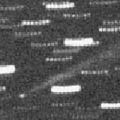
|
New comet with a very short period of 4.6 years. Almost stellar, with a long thin tail. It locates at opposition in November and December. In the Northern Hemisphere, it is observable in excellent condition. It keeps 16.4 mag in November, however, it will fade out very rapidly in December.
Date(TT) R.A. (2000) Decl. Delta r Elong. m1 Best Time(A, h)
Nov. 18 5 3.60 21 48.5 0.553 1.516 158 16.4 1:18 ( 0, 77)
Nov. 25 4 39.11 20 9.3 0.622 1.605 171 16.4 0:26 ( 0, 75)
|
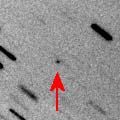
|
Although it was so faint as 20.7 mag on Aug. 2 (P. Birtwhistle), it brightened rapidly as expected, and reached up to 16.5 mag on Oct. 16 (Katsumi Yoshimoto). The condition of this apparition is excellent. It keeps 16.5 mag until November. But it will be fainter than 18 mag in December.
Date(TT) R.A. (2000) Decl. Delta r Elong. m1 Best Time(A, h)
Nov. 18 5 16.35 58 37.1 0.599 1.480 136 16.5 1:30 (180, 67)
Nov. 25 5 12.55 62 38.9 0.614 1.493 136 16.7 0:59 (180, 63)
|

|
Now it is fading, and it will be fainter than 18 mag in December.
Date(TT) R.A. (2000) Decl. Delta r Elong. m1 Best Time(A, h)
Nov. 18 23 22.65 31 38.3 1.020 1.765 122 16.8 19:33 ( 0, 86)
Nov. 25 23 26.46 28 27.9 1.143 1.825 117 17.2 19:10 ( 0, 83)
|
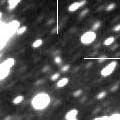
|
It keeps 17 mag for a long time after this until the end of 2007. It will be observable in good condition in 2006 autumn and 2007 autumn.
Date(TT) R.A. (2000) Decl. Delta r Elong. m1 Best Time(A, h)
Nov. 18 20 17.04 36 24.3 3.557 3.643 87 16.9 18:20 (102, 67)
Nov. 25 20 27.17 35 33.7 3.593 3.630 84 16.9 18:18 (101, 64)
|
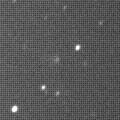
|
It reached up to 16 mag in 2005 summer in the Southern Hemisphere. Now it is 16.6 mag (Sept. 19, Mitsunori Tsumura). The brightening was very slow, and the fading seems also very slow. It will keep 17 mag until January after this. But then it will turn to fade out rapidly, and will be fainter than 18 mag in February.
Date(TT) R.A. (2000) Decl. Delta r Elong. m1 Best Time(A, h)
Nov. 18 5 32.66 -23 15.5 4.253 4.929 128 17.0 1:46 ( 0, 32)
Nov. 25 5 27.81 -22 56.0 4.255 4.966 131 17.0 1:14 ( 0, 32)
|

|
First return of a new bright periodic comet observed at 9 mag in 2001. But it has not been recovered yet. The condition of this apparition is bad. It keeps locating very low in the evening. But it is expected to reach up to 11 mag in February and March. It should be already so bright as 17 mag. But it may be much fainter in fact. It will be brightening rapidly after this.
Date(TT) R.A. (2000) Decl. Delta r Elong. m1 Best Time(A, h)
Nov. 18 18 35.29 -12 47.2 2.183 1.629 44 17.5 18:20 ( 57, 20)
Nov. 25 18 51.64 -12 49.9 2.161 1.563 41 17.0 18:18 ( 58, 19)
|
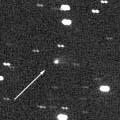
|
It kept 16.5 mag for a year and a half since early 2005. It will start fading after November, and will be fainter than 18 mag at the end of 2006.
Date(TT) R.A. (2000) Decl. Delta r Elong. m1 Best Time(A, h)
Nov. 18 23 33.19 25 52.6 3.426 4.072 124 17.1 19:44 ( 0, 81)
Nov. 25 23 33.09 23 41.1 3.550 4.111 118 17.2 19:16 ( 0, 79)
|

|
It is outside of Jupiter's orbit. So it keeps 17 mag for a long time until 2007 summer. It had been low temporarily, however, it keeps locating high and observable in good condition for a long time after this because it moves in the northern sky.
Date(TT) R.A. (2000) Decl. Delta r Elong. m1 Best Time(A, h)
Nov. 18 14 23.91 38 32.9 7.486 7.041 59 17.1 5:09 (240, 27)
Nov. 25 14 28.00 38 10.6 7.449 7.053 62 17.1 5:15 (243, 32)
|
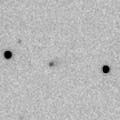
|
It reached to 16 mag in early 2006. It will be fading very slowly from 17 mag to 18 mag until 2007 summer. In the Northern Hemisphere, it keeps locating high.
Date(TT) R.A. (2000) Decl. Delta r Elong. m1 Best Time(A, h)
Nov. 18 13 38.37 31 39.3 5.882 5.418 57 17.2 5:09 (252, 32)
Nov. 25 13 44.61 31 18.0 5.841 5.439 61 17.2 5:15 (255, 37)
|

|
Peculiar asteroid moving along an orbit like a comet. It was observable in excellent condition at opposition in October, then it reached to 16.5 mag. It will fade out gradually after this, and will be fainter than 18 mag in January.
Date(TT) R.A. (2000) Decl. Delta r Elong. m1 Best Time(A, h)
Nov. 18 0 56.28 -7 31.6 1.424 2.221 133 17.2 21:07 ( 0, 47)
Nov. 25 0 57.21 -7 42.4 1.462 2.198 126 17.3 20:40 ( 0, 47)
|
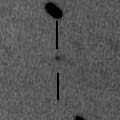
|
Now it is 16.9 mag (Oct. 20, Filip Fratev). The perihelion passage is in 2008. It will be observable for several years after this at around 17 mag. But it may fade out rapidly just after the perihelion passage.
Date(TT) R.A. (2000) Decl. Delta r Elong. m1 Best Time(A, h)
Nov. 18 4 42.04 10 35.8 3.826 4.773 161 17.2 0:56 ( 0, 66)
Nov. 25 4 38.15 10 36.4 3.794 4.760 166 17.2 0:24 ( 0, 66)
|

|
It keeps 17 mag until January. Then it keeps observable util April when it becomes fainter than 18 mag.
Date(TT) R.A. (2000) Decl. Delta r Elong. m1 Best Time(A, h)
Nov. 18 4 36.95 51 53.9 3.001 3.852 144 17.2 0:51 (180, 73)
Nov. 25 4 31.04 52 13.4 2.974 3.847 147 17.2 0:18 (180, 73)
|
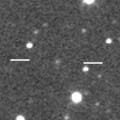
|
Unexpectedly bright as 17 mag on Oct. 16 (Michael Jager and Gerald Rhemann). It is observable at 17.5 mag in good condition until December.
Date(TT) R.A. (2000) Decl. Delta r Elong. m1 Best Time(A, h)
Nov. 18 2 30.59 30 0.8 1.448 2.409 162 17.3 22:40 ( 0, 85)
Nov. 25 2 25.43 30 1.2 1.477 2.414 156 17.4 22:08 ( 0, 85)
|

|
Now it is 16.3 mag (Oct. 14, Ken-ichi Kadota). It is as bright as in last spring. It will be fainter than 18 mag in December.
Date(TT) R.A. (2000) Decl. Delta r Elong. m1 Best Time(A, h)
Nov. 18 2 26.10 -12 32.1 1.584 2.457 144 17.4 22:34 ( 0, 42)
Nov. 25 2 4.02 -14 45.1 1.724 2.515 134 17.7 21:45 ( 0, 40)
|
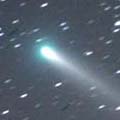
|
It reached to 6 mag at best in early May at the remarkable approach to the earth, when it became double naked eye comets with the component B around the zenith. Now it is going away from the earth and fading. Recently it is fading more slowly than expected. It was visible visually at 13.9 mag still in late September (Sept. 27, Seiichi Yoshida). Now it has faded down to 17.4 mag (Nov. 9, Y. Sugiyama). It keeps locating in the evening sky for a while after this. But it will be fainter than 18 mag soon.
Date(TT) R.A. (2000) Decl. Delta r Elong. m1 Best Time(A, h)
Nov. 18 0 28.64 -10 27.6 1.491 2.220 125 17.5 20:39 ( 0, 45)
Nov. 25 0 29.38 -9 14.4 1.621 2.280 119 17.8 20:12 ( 0, 46)
|

|
Peculiar asteroid moving along an orbit like a comet. It was observed at 17 mag in February and March. It will be observable at 17 mag again in October and November. But it will fade out soon.
Date(TT) R.A. (2000) Decl. Delta r Elong. m1 Best Time(A, h)
Nov. 18 1 35.29 25 53.0 1.505 2.424 152 17.7 21:43 ( 0, 81)
Nov. 25 1 11.05 21 54.6 1.627 2.469 140 18.0 20:52 ( 0, 77)
|
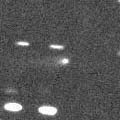
|
Now it is 17.3 mag (Oct. 19, Catalina Sky Survey). It is as bright as last year. It will be fainter than 18 mag in December.
Date(TT) R.A. (2000) Decl. Delta r Elong. m1 Best Time(A, h)
Nov. 18 1 10.70 19 20.4 4.677 5.530 146 17.7 21:20 ( 0, 74)
Nov. 25 1 2.97 18 34.3 4.775 5.548 138 17.8 20:45 ( 0, 74)
|

|
Although it moves very far away from the earth, now it is brightest around the perihelion. It keeps observable in good condition at 18 mag until February.
Date(TT) R.A. (2000) Decl. Delta r Elong. m1 Best Time(A, h)
Nov. 18 5 54.72 20 26.7 2.742 3.608 146 17.8 2:08 ( 0, 75)
Nov. 25 5 51.14 20 8.2 2.693 3.608 154 17.7 1:37 ( 0, 75)
|

|
It reached to 6 mag in 2004. It had been visible visually until January. It has already faded down to 17.2 mag (Sept. 27, Ken-ichi Kadota). It will be fading slowly, around 17-18 mag for a while after this.
Date(TT) R.A. (2000) Decl. Delta r Elong. m1 Best Time(A, h)
Nov. 18 2 24.36 -4 43.0 7.428 8.306 150 17.7 22:34 ( 0, 50)
Nov. 25 2 20.56 -4 47.0 7.538 8.361 144 17.8 22:03 ( 0, 50)
|

|
Now it is 17.9 mag (Oct. 1, Ken-ichi Kadota). It will reach to 15 mag two years later.
Date(TT) R.A. (2000) Decl. Delta r Elong. m1 Best Time(A, h)
Nov. 18 2 3.88 6 45.8 3.575 4.492 155 17.8 22:14 ( 0, 62)
Nov. 25 2 0.44 6 36.8 3.621 4.485 147 17.8 21:43 ( 0, 62)
|
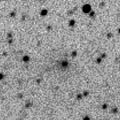
|
Now it is around the aphelion and faintest. But it will be observable at 18 mag in good condition until March. It will be 13-14 mag and visible visually again in 2009. It will reach to 12.5 mag in 2010. But in the Northern Hemisphere, it will locate very low in the south at that time.
Date(TT) R.A. (2000) Decl. Delta r Elong. m1 Best Time(A, h)
Nov. 18 6 25.88 27 31.7 3.935 4.730 139 17.9 2:39 ( 0, 83)
Nov. 25 6 22.34 27 44.9 3.868 4.729 147 17.8 2:08 ( 0, 83)
|

|
Recovered after 15 year blank since last apparition in 1991. It was originally expected to brighen up to 14.5 mag in 2006 summer. But actually, it was so faint as 20 mag, fainter than expected by 6 mag. It became a bit brighter on Sept. 18 up to 18.8 mag (Ken-ichi Kadota).
Date(TT) R.A. (2000) Decl. Delta r Elong. m1 Best Time(A, h)
Nov. 18 3 1.76 61 14.2 1.555 2.380 137 20.2 23:11 (180, 64)
Nov. 25 2 51.52 60 42.9 1.583 2.409 138 20.3 22:33 (180, 64)
|
|
![]()
 C/2005 YW ( LINEAR )
C/2005 YW ( LINEAR ) D/1986 W1 ( Lovas 2 )
D/1986 W1 ( Lovas 2 ) P/2006 HR30 ( Siding Spring )
P/2006 HR30 ( Siding Spring ) 177P/2006 M3 ( Barnard 2 )
177P/2006 M3 ( Barnard 2 ) C/2003 WT42 ( LINEAR )
C/2003 WT42 ( LINEAR ) P/2006 T1 ( Levy )
P/2006 T1 ( Levy ) C/2005 E2 ( McNaught )
C/2005 E2 ( McNaught ) 76P/West-Kohoutek-Ikemura
76P/West-Kohoutek-Ikemura C/2006 K3 ( McNaught )
C/2006 K3 ( McNaught ) 84P/Giclas
84P/Giclas C/2005 EL173 ( LONEOS )
C/2005 EL173 ( LONEOS ) 117P/Helin-Roman-Alu 1
117P/Helin-Roman-Alu 1 114P/Wiseman-Skiff
114P/Wiseman-Skiff 71P/Clark
71P/Clark 52P/Harrington-Abell
52P/Harrington-Abell P/2006 U1 ( LINEAR )
P/2006 U1 ( LINEAR ) 112P/Urata-Niijima
112P/Urata-Niijima (3200) Phaethon
(3200) Phaethon C/2006 M1 ( LINEAR )
C/2006 M1 ( LINEAR ) C/2004 L2 ( LINEAR )
C/2004 L2 ( LINEAR ) P/2001 Q2 ( Petriew )
P/2001 Q2 ( Petriew ) C/2005 B1 ( Christensen )
C/2005 B1 ( Christensen ) C/2002 VQ94 ( LINEAR )
C/2002 VQ94 ( LINEAR ) C/2004 D1 ( NEAT )
C/2004 D1 ( NEAT ) 2006 QL39
2006 QL39 173P/2005 T1 ( Mueller 5 )
173P/2005 T1 ( Mueller 5 ) P/2005 SB216 ( LONEOS )
P/2005 SB216 ( LONEOS ) P/2006 S6 ( Hill )
P/2006 S6 ( Hill ) C/2006 CK10 ( Catalina )
C/2006 CK10 ( Catalina ) 73P-C/Schwassmann-Wachmann 3
73P-C/Schwassmann-Wachmann 3 2006 BZ8
2006 BZ8 C/2005 R4 ( LINEAR )
C/2005 R4 ( LINEAR ) P/2005 RV25 ( LONEOS-Christensen )
P/2005 RV25 ( LONEOS-Christensen ) C/2003 K4 ( LINEAR )
C/2003 K4 ( LINEAR ) 74P/Smirnova-Chernykh
74P/Smirnova-Chernykh 65P/Gunn
65P/Gunn 102P/Shoemaker 1
102P/Shoemaker 1![]()





























